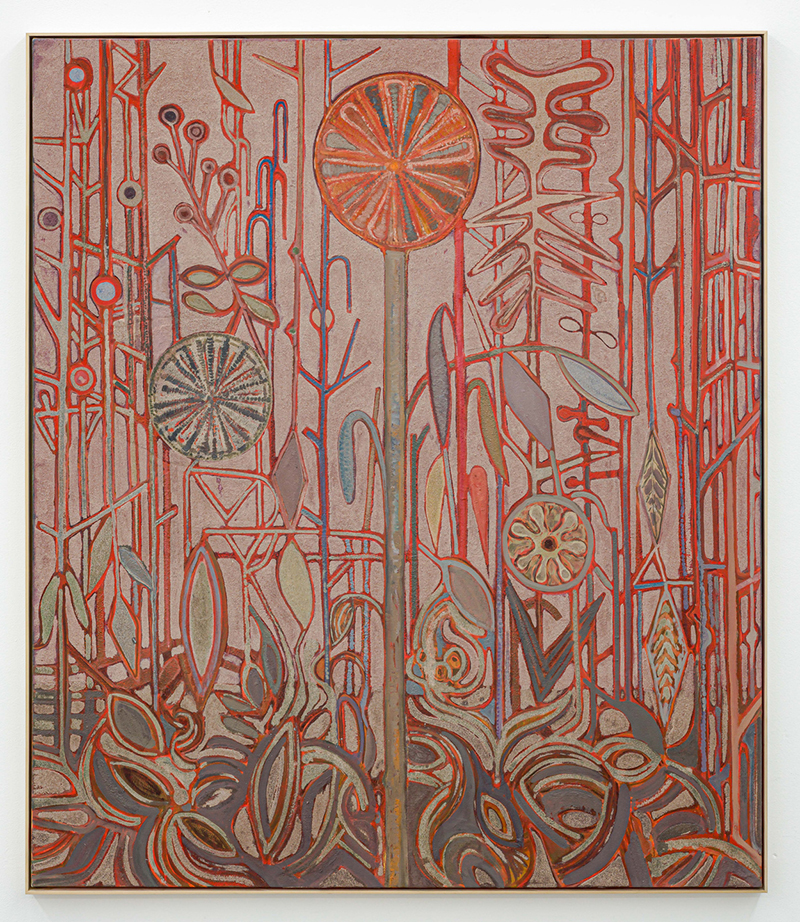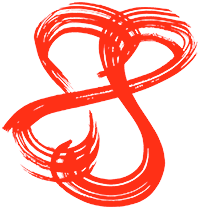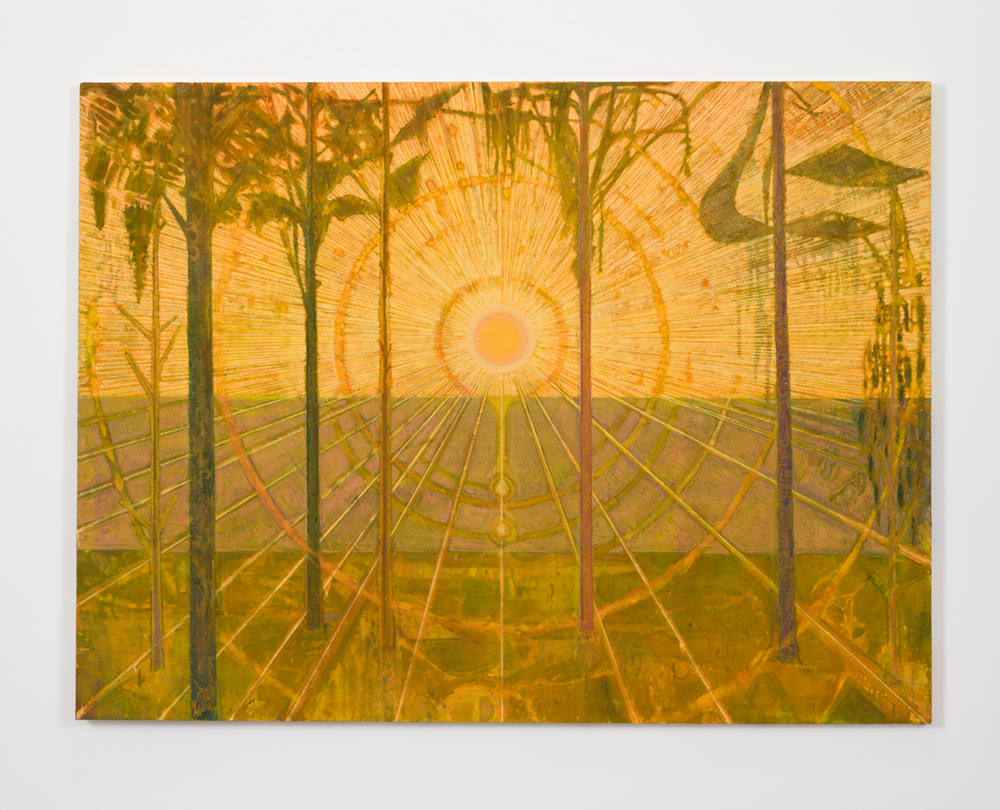More than Words
Sky, it’s a pleasure to speak to you about your work. As is increasingly common, I first encountered your work online via Instagram. Despite the reductive nature of this platform your paintings of vibrant flora and heady landscapes really spoke to me. Investigating your website I was fascinated by the varied but interconnected bodies of work that feed into your current practice. My first question is about words. There is an absence of them on your website. There is no statement or work titles. Can you say something about your feelings towards words, and how you use them as an artist?
Thanks for reaching out. It’s interesting how these new spaces, although limiting in certain aspects, are also quite liberating and conducive to new conversations. One note on Instagram is that anyone who has seen my work there hasn’t really seen it. For the most part the works are quite large, and the surfaces are the result of layers upon layers of thin stains of oil and turpentine and sand. Anyway, the works are different in person, but there is something in Instagram that forces you to distill the painting into an image, like the distillation of prose into an haiku. So, it has its strengths I suppose.
As to your question about words; It's true, there is a lack of explanatory texts on my website. I think it would be good to have more information about the work. Maybe I will commission someone to shoot little vignettes of us talking about the work. Writing about it would take as much effort as actually making the work and I just don’t have the energy or the time. I have done some writing about each body of work I have made; I just have not included this on my website. Perhaps it’s something I should do. On the other hand, when I start filling in the blanks and explaining things it takes something away from the person who might be seeing things differently, who would write about it differently and bring new ideas to bear on the work. I feel that everyone can bring something to a painting and the artist, in some sense, is just another voice - not necessarily the most authoritative or even trustworthy - as often times I really do not know what is going on in a painting.
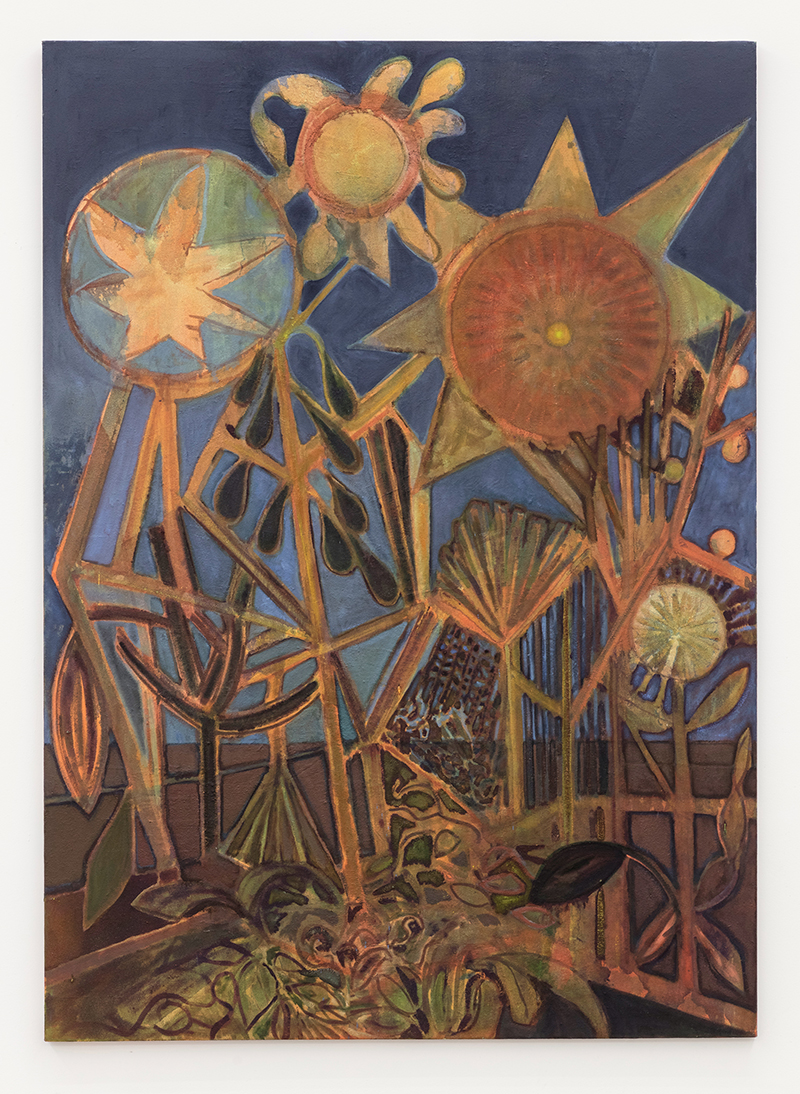
Sky Glabush, 'Gleanings', 2018, oil and sand on canvas, 244 x 183 cm. Image courtesy of the artist and Clint Roenisch Gallery.
Modernism
Looking through your earlier work and image research I catch glimpses of Bauhaus Masters; Loose references to Josef Itten’s colour theory or Gunta Stölzl’s gorgeous weavings. These references were also important to my earlier work as I wanted to try and connect with the ‘fundamentals’ of aesthetic theory and was curious about the connection between play and pedagogy. What promise and attraction do Modernist approaches hold for you?
I am a dyed in the wool modernist. I live and breathe modernist history, especially the moment leading up to abstraction, when the image was being destroyed, distilled, invented, and transformed, but was still an image. I grew up in Saskatoon, Saskatchewan which was a hotbed of abstract painting. My father-in-law Otto Rogers was a very well-respected and influential painter. This was the environment in which I learned to look at paintings. One of the first art books I ever read was “The Cubist Epoch” by Douglas Cooper. When I went to school there was a lot of out and out hostility to this type of work and this view of history. But I spent several years making little cubist still lives and collages. At one point I took a class in Regina Saskatchewan Indian Federated College ("SIFC") (now First Nations University of Canada) from the renowned artist Bob Boyer. He was very political, very pointed and sharp in his thinking and criticism. But he was deeply immersed in the history of modern painting and the history of abstraction. He used these tools to tell a different story. He encouraged me to keep looking at modernist art, but to try to bring it into the present. In his class (in which I was the only student) I would cast lead on blankets and create paintings on leather jackets or plaster. There was a lot of experimenting and although Bob was quite cantankerous and provocative, he was showing me a way forward.
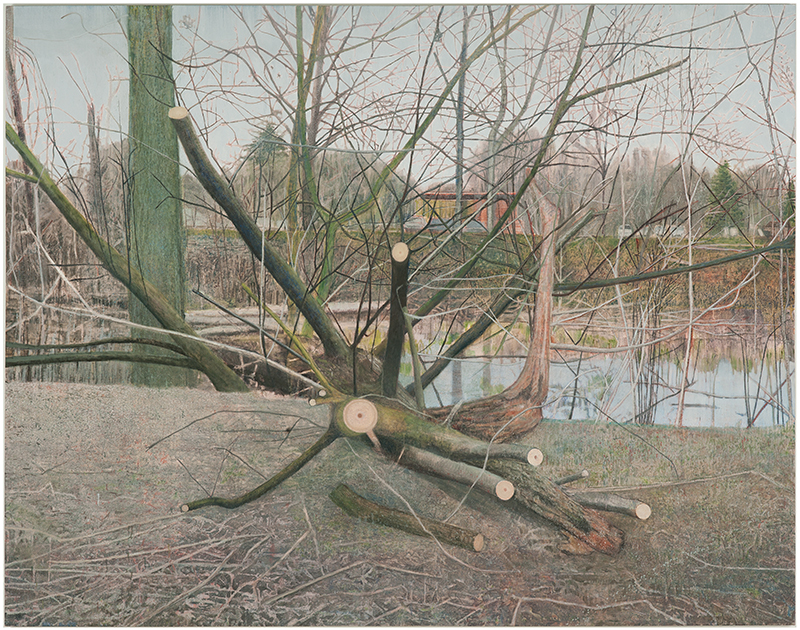
Sky Glabush, 'Cut Tree', 2011, oil on canvas, 213.4 x 274.3 cm. Collection of David Clark and Tracy Wynne. Image courtesy of the artist.
Without going into too much more detail, I struggled to find my voice, I struggled to revel in the material language of painting while trying to be relevant. It led to a move to Amsterdam where I lived with my family for 3 years. I had another decisive encounter there with the artist Navid Nuur. Like Boyer, he was extremely blunt. He looked at what I was doing and really dismissed it. I was making landscape painting, covering them with wax or epoxy, and then adding things like stripes or dots to the surface. He said “What are you doing? What are these about?” and I responded that I was painting the landscape. He said “bullshit: Look at the landscape, it doesn’t look anything like that.” He was right. This led to a series of works, my first sort of real project in which I photographed housing complexes in and around Amsterdam and made detailed collages of them. I continued this work when I returned to Canada. I was trying to explore modernist aesthetics and philosophy as it applied to social design.
But after a few years of trying to craft very precise responses to the landscape I grew weary of this, and when I moved to London Ontario to begin teaching at the University here, I started painting the rental houses around the school. Again, after a few years of this I grew tired of working from photography and such specific subject matter. I then returned to my early interest in modernist strategies, especially the emphasis on craft, the hand, experimentation, play, the imagination. This answer is getting too long.
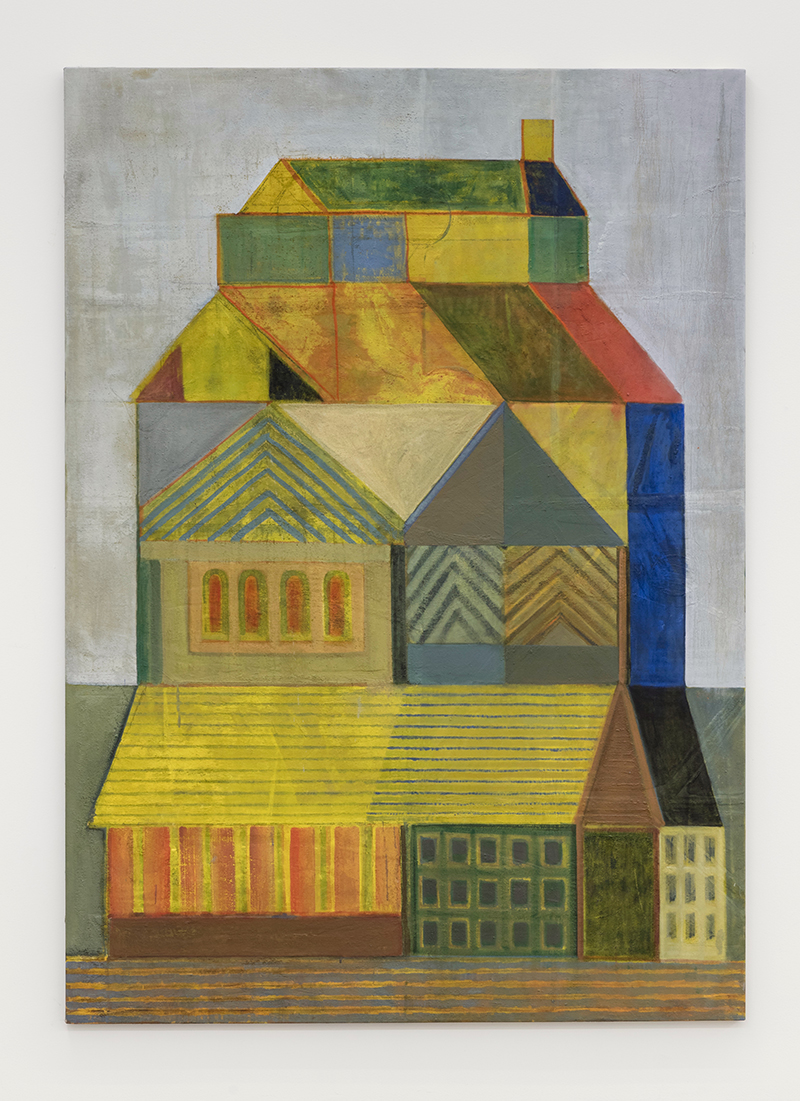
Sky Glabush, 'Boarding House', oil and sand on canvas, 213.6 x 152.6 cm. Collection of the National Gallery of Canada. Image courtesy of the artist and Clint Roenisch Gallery.
Weaving
Can you tell me a little about the weaving element of your practice and how this craft (perhaps repetitive and laborious) sits alongside your image making?
So yes, to follow on from the last point, my explorations into say Bauhaus experimentation was born out of desperation. I was really struggling to find a way to work after months of artist’s block in the studio. I began by taking small off-cuts of wood and gluing them together to make little models or reliefs. I would paint them, pour wax on them, fill them with plaster, cut back into them. I absolutely loved this period in the studio. It led me to experiment with diazo prints, with sand painting, with glass sculpture, with wall reliefs, watercolours, and with textiles. I bought a loom and joined the weaver’s guild where Pat Zannier taught me everything I know on the loom. It was therapeutic, meditative and healing. I am grateful for those strategies as they saved me spiritually and artistically.
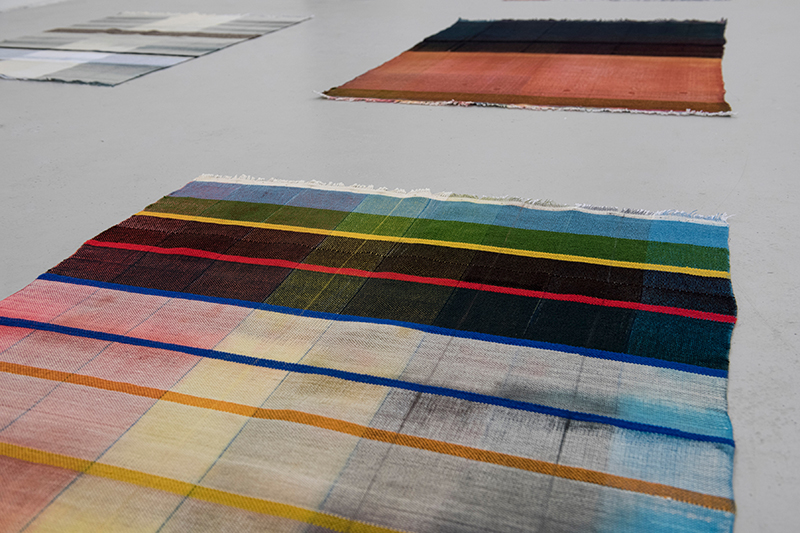
Sky Glabush, Instalation shot of 'The Window is Also a Door', solo exhibition at Prosjektrom Normanns, Stavanger, Norway, 2016. Image courtesy of the artist and Prosjektrom Normanns.
Background
I think you have been painting for a long time (since the early 2000’s?) yet you begin your portfolio with the exhibition ‘Background’, at MKG127 in 2011. Can you tell me about the significance of that show for you and why it is a good starting point for everything that comes afterwards?
Yes! After about a year of experimenting in the studio, the resulting exhibition was “Background.” Gallerist Michael Klein was very generous in allowing me the space to do this. In that show I was triangulating three aspects of modernity: abstraction, spirituality and memory. This is what I wrote for that show: “My parents, who met on a commune in Sointula, British Columbia, were part of that generation that tried to imagine a new way of life by moving “back to the land,” constructing their own homes, and expanding their consciousness. In 1976, my father checked himself into the Angus Campbell Treatment Centre in Moose Jaw, and shortly afterwards discovered the Baha’i Faith. Starting from this personal, even diarist position where the polarities of hippy culture, recovery and religion converge in my memory, this work shifts into a larger question about the “the spiritual in art.” And rather than sealing off this question within the universal language of abstraction I have sought to pose it against the peculiar specificity and symbolic register of my experience.”
This show was extremely valuable to me and my development and I think of it as my first real show even though there were many before it and works I made in the past that I still value.
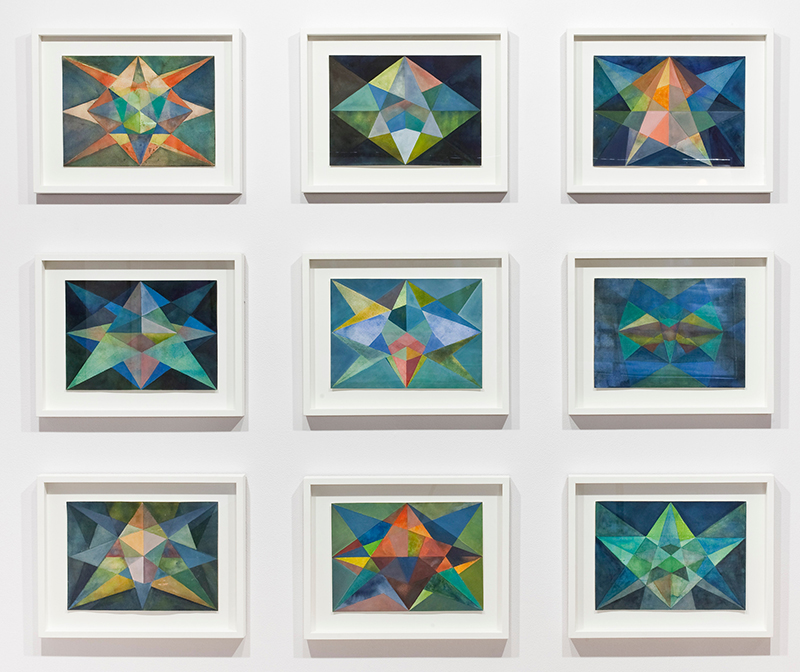
Sky Glabush, 'The Secret Doctrine (parts one to nine), 2011, watercolour on paper. Image courtesy of the artist and MKG127.
Scaffolding
In the press release for your solo show ‘The Caged Lark’ at Philip Martin Gallery earlier this year you say that ‘It took me twenty years of working to get to that stage where I could let go of the scaffolding of an image, and work in an open way.’ Can you say more about this and what may have facilitated this sense of ‘letting go’?
That was taken from a live interview. It is not exactly what I meant. What I was trying to say is that for many years I was using photography. These different strategies that I mentioned above allowed me to break free of the photograph and to use the image in a different way. To allow it to be a form, a motif, but not a literal thing, not a reproduction of something. Image is like the chords in a song: it allows for improvisation and play. Images have baggage and history: this too can be mobilized. Working directly from photographs was choking this. It took me 20 years to find my own language and process.
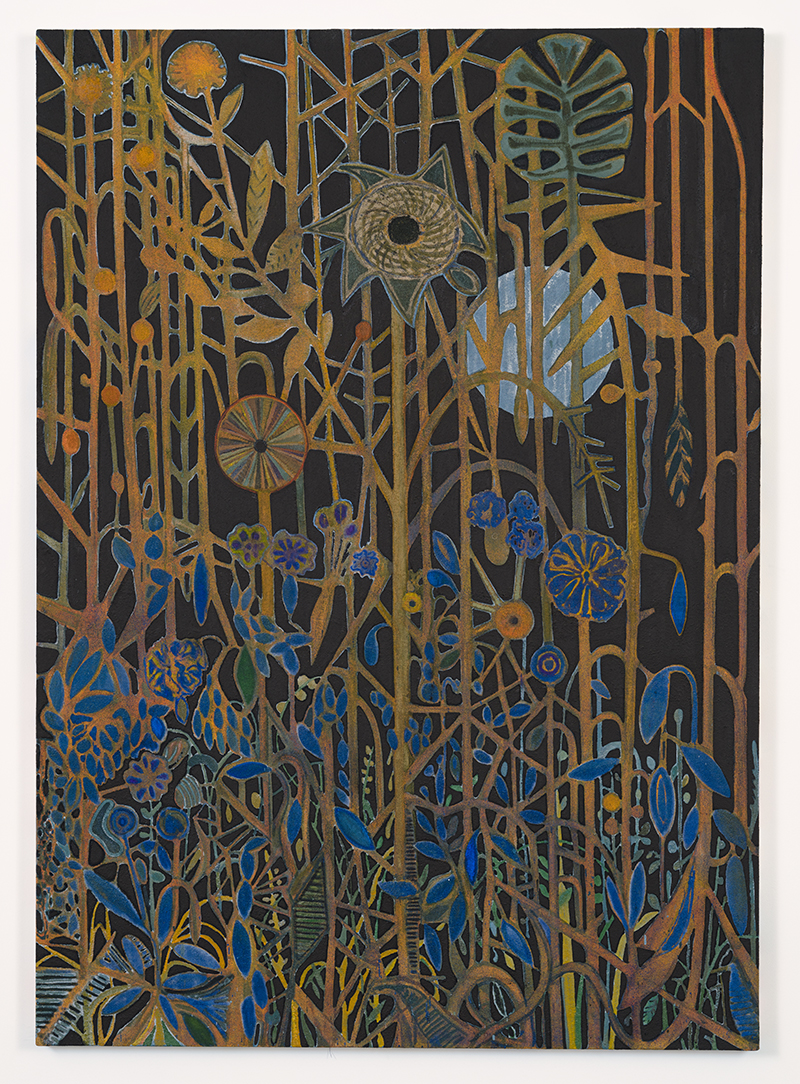
Sky Glabush, 'Caged Lark', 2020, oil and sand on canvas, 213.4 x 152.4 cm. Image courtesy of the artist & Philip Martin Gallery.
Beginning and Ending
How do you begin a painting? Do you do studies? Do you stick to plans or use your intuition? How do you know when a piece is finished?
This is too complicated to spell out here. But in short, I start with an idea. For example, I am working on a painting of a butterfly. It is 8’ tall by 6’ wide. It came to me when I was staying at my uncle and aunts house in BC. They had a bedspread with a butterfly on it and I thought to myself that it would make a good painting. I forgot about it for a few years and recently the image came back to me quite clearly when I woke up.
So, I began by making watercolours and sketches of butterflies and moths. When I had a basic idea I drew a rough sketch of this out on the canvas. I will paint the butterfly relatively close to these studies. Then I will paint over it with layers of thin oil paint like yellow or red. This completely flattens out the image and kind of destroys it. I then take chalk and begin to find passages and movements underneath, areas that I try to rebuild. Once I repaint the image I will often repeat this process and throw sand into the wet paint. I stop when it stops looking like a rendition of something and starts to look like it is its own thing. For example, when I see a tree, I don’t think that the tree is trying to represent a tree. For me painting has to have this same sort of character. It is a contrivance, an illusion, but it should feel like it came into being kind of on its own; It has something specific that it is trying to say and as an artist you are trying to hear it. This is impossible to write about. You know it when you see it. And you really know it when you don’t.
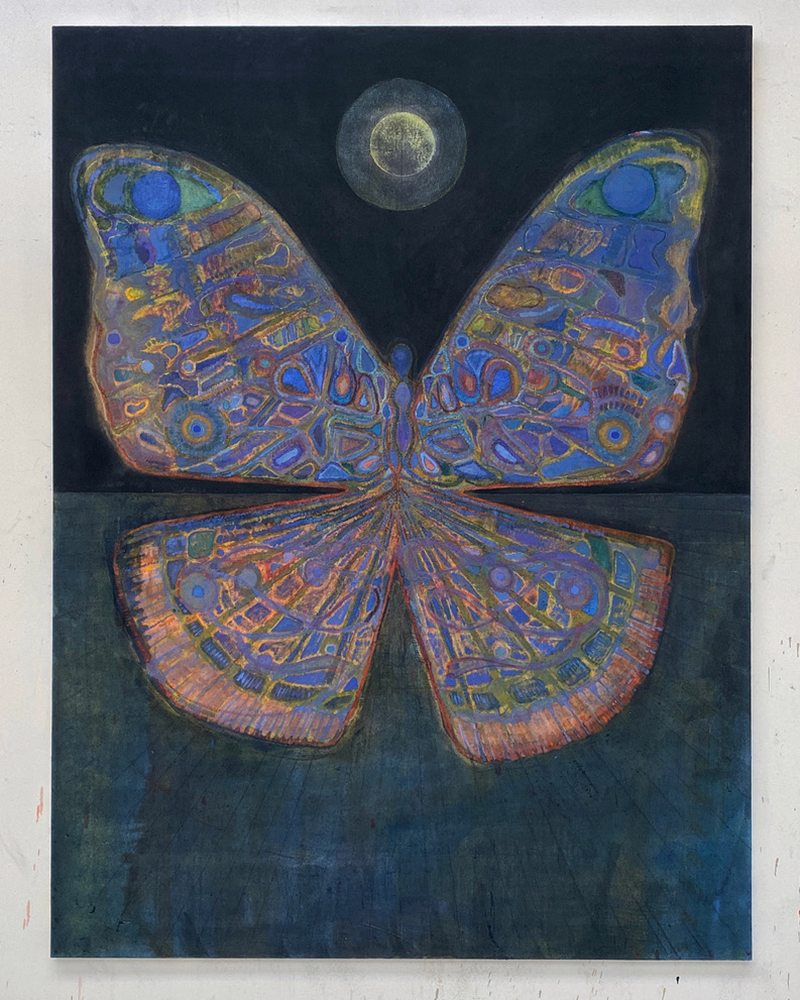
Sky Glabush, 'Moth', oil and sand on canvas, 243.8 x 182.9 cm. Image courtesy of the artist & Philip Martin Gallery.
Land
Landscape reappears as a subject in your work; from the suburban streets of ‘Renting’ (2009) to your more recent visionary depictions of forests, lakes and mountains. What is the significance of the landscape for you? Do you show us real places? Do you work from observation, memory or imagination? Are you in dialogue with other painters of place?
This is another really good question and also one that is too complicated to truncate. But I will say that I paint flowers, people, buildings, animals. Many of my recent shows have included flowers and portraits. But the larger paintings tend to be spaces where some improvisation can happen. If it is too specific it makes it hard for me to transform and rebuild. I get caught up in the image and try to preserve the little character in the corner of the house or the flower. I need to be able to completely obliterate something by pouring sand over it and repainting it. Smaller elements tend to get burned off and all you are left with is a forest or a plain or a mountain. These are structures that allow me to get lost. I am hesitant to see myself as a landscape painter as I paint many other things like those I just mentioned. But it’s the amalgamation of these things that is the challenge. I need to be able to get to the point where people, animals, flowers, birds are all inhabiting a space. But I guess my fear is to return to a kind of imagistic method where I am beholden to a preconceived idea or picture.
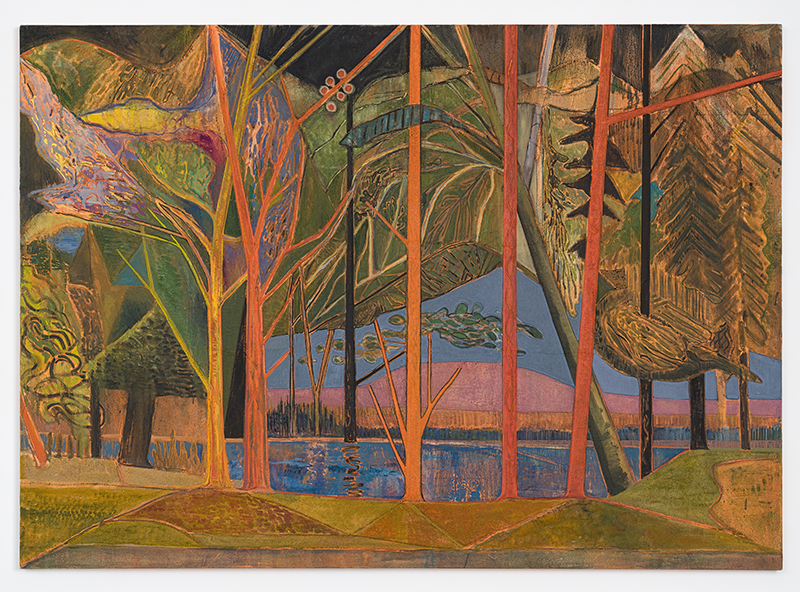
Sky Glabush, 'Lake In The Forest', 2020, oil and sand on canvas, 152.4 x 213.4 cm. Image courtesy of the artist & Philip Martin Gallery.
Love
I’d like to ask about the place for love within your works; be this devotional, interpersonal or radical. Is this something you ever think about or feel in relation to your practice? Love seems like something we’re not allowed to talk about as artists or lecturers.
I am a member of the Baha’i Faith. This is very important to me. In the teachings of Baha’u’llah, love is the central theme. Love is light, it is the eternal breath, the vital bond, love is a way out of darkness, it is the law, the unique power that binds together the atoms and diverse elements of reality into a coherent whole, a oneness. Yes, it is very important in my art. And you are very right, we cannot talk about it. Maybe because words are cheap and it is better to express love in action. But love permeates a lot of the work I am attracted to. I do not deny that art can express anger, pain, revulsion, chaos, confusion. Some of the greatest works of art I have seen are about hell, like Bosch’s “Garden of Earthly Delights”. Some of my favourite paintings are about loss and emptiness. But also, there is love. And it seems to permeate an artist like Bonnard. He painted what he loved. His painting rings true for me.
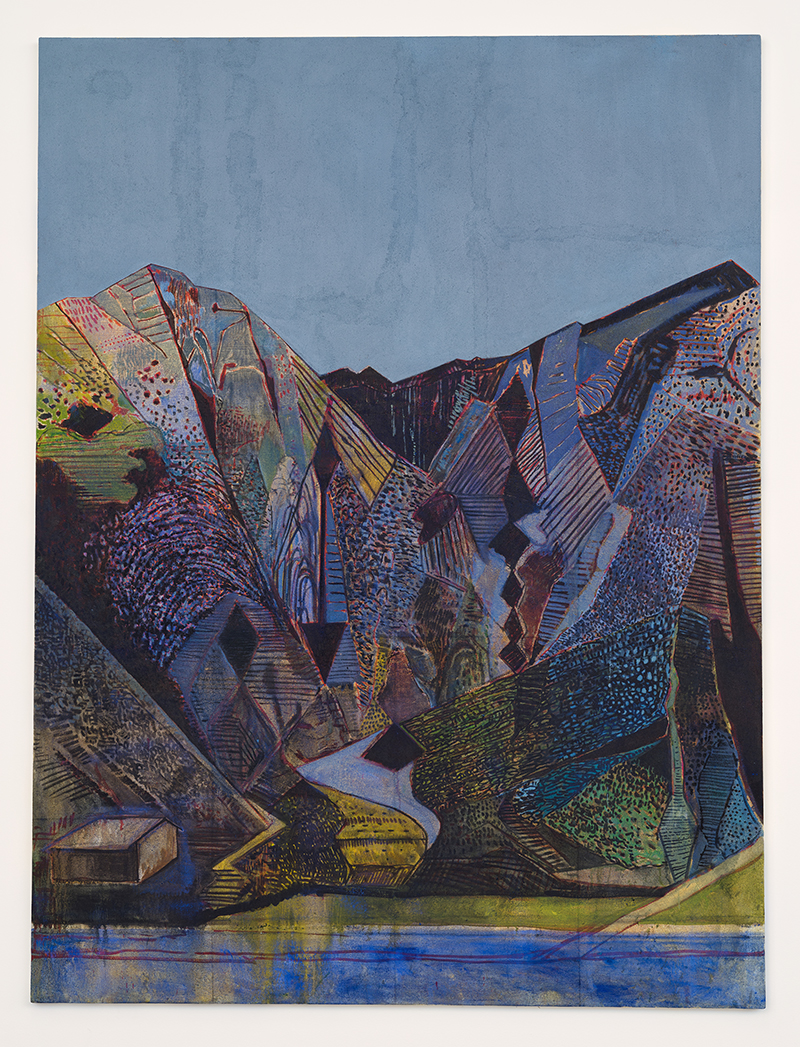
Sky Glabush, 'Magic Mountain', 2020, oil and sand on canvas, 243.8 x 182.9 cm. Image courtesy of the artist & Philip Martin Gallery.
Exhibition
You have a solo exhibition coming up at Philip Martin Gallery, opening on 20th November. Can you tell me a little about your approach or focus for this exhibition?
One of the central pieces in the show is of the night sky. This image came to me very clearly. I simply drew little circles on the canvas and started to layer darker washes over it to make points of light radiate. I then went back into the painting and started to flatten some of these stains with other colours like crimson and ochre and grey paint. I suppose there is a reference to Van Gogh, but the artist I was thinking about for this piece was Paterson Ewen. He too lived in London Ontario and taught at my university. He is my favourite Canadian painter. I have been emulating much of what I can understand from his work and I have been trying to incorporate his approach to narrative, to simplicity and directness, to physicality and ultimately to a kind of visual poetry. The other artist I was thinking about is Ross Bleckner. I used to look at his work a lot in the 90’s and this approach to the light is an echo of some of the elegiac paintings about death and beyond.
I also made a painting of the sun called “Weight of light.” the title is from a poem by Walt Whitman. This idea, like the night painting just came to me. It is a completely over done subject and very hard to approach. I divided the canvas in half: the upper part the sun in the sky, the lower its reflection on water. I spent a long time on the reflection. I knew that I could map out the burning orb, but the reflection looked very fake. I used a lot of turpentine and kept peeling away layers and restaining. In short, the painting is about making something ephemeral and fleeting like the rays of the sun into something direct and concrete and solid.
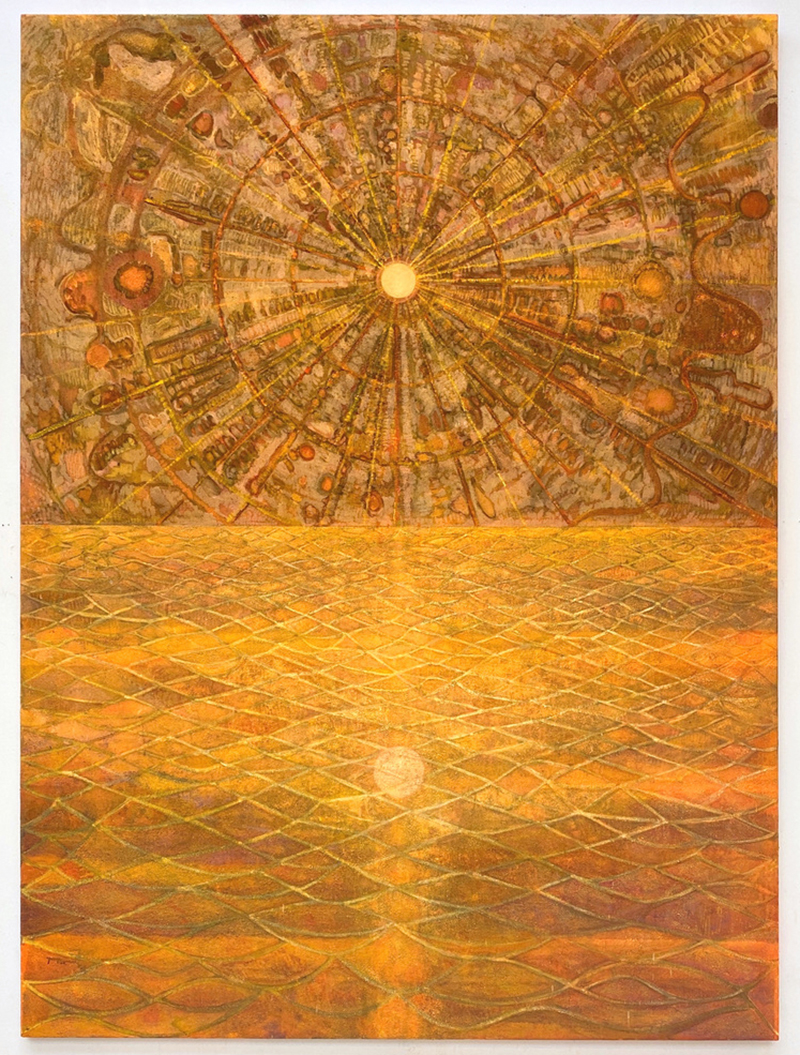
Sky Glabush, 'Weight of Light', 2021, oil and sand on canvas, 243.8 x 182.9 cm. Image courtesy of the artist & Philip Martin Gallery.
Friends
Finally, which artists do you look to and appreciate from history and our present moment?
Peter Doig has haunted me since I was in art school. I have fallen in and out of love with his work, and I have been frustrated by it as every time I turn a corner and discover something novel and inventive, I realize he has already been there. But I am deeply inspired by his approach, and I look to him for guidance. Kai Althoff is another artist, whose work is more mercurial and rhapsodic than Doig’s, but resonates very deeply for me. I saw his show at Tramps in NY a few years back and that show stays with me. I wanted to see his recent show at the Whitechapel Gallery in which he featured the work of Bernard Leach. Bernard Leach was also a Baha’i and is a huge influence on me so to see his work in relation to Althoff’s would have been a dream. I ordered the catalogue in October 2020 but it never came. Gillian Carnegie is a painter I look to, also; Allison Katz, Andrew Cranston, Maja Ruznic, Rema Ghuloum, Tarwuk. There is a young painter whose work is really grabbing me hard, by the name of Justin Caguiat although I have only seen images on Instagram. Guglielmo Castelli, who I showed with in Berlin; I like Elizabeth McIntosh, Brenda Draney, Veronika Pausova, Joani Tremblay, Uwe Henneken.
Both my parents are artists. My father Ted Glabush makes beautiful works that often incorporate mosaic tiles and wood and found materials a bit like Jack Whitten. And my mother makes gorgeous, rapturously religious paintings from the Bible in a similar vein to Bonnard, but with more of an emphasis on describing a story like that of the garden or Exodus. My mother studied art at UBC with the painter Jack Shadbolt. I was surrounded by her work growing up and I’m certain that this still influences my understanding of art.
